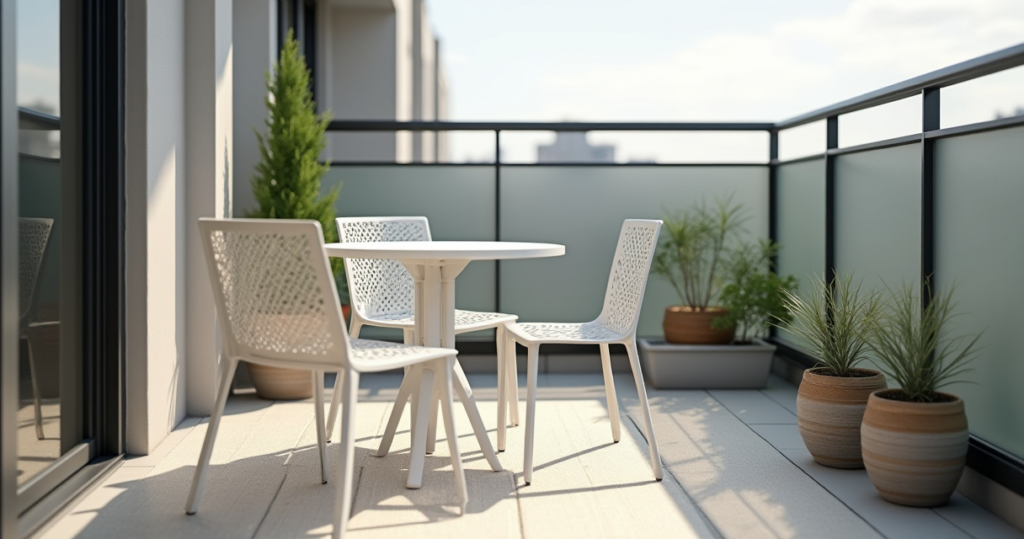A friend asked me about this the other day. They saw one of those online articles with endless pictures of balconies crammed with stuff and felt overwhelmed. “How do you even begin?” they asked. “And how do you make it feel… calm?”
I’ve noticed something about how we approach these small outdoor spaces. We are taught to think of them as problems to be solved with more. More furniture, more plants, more decor. We try to maximize them. But in our tradition, space is not something to be conquered. It is something to be understood. The most profound “shortcut” is not about adding more, but about seeing what is already there. It’s about understanding the sky above, the air that moves through, the concrete floor beneath your feet. It’s about finding the purpose of the space first.
The goal isn’t to fill your balcony. The goal is to create a feeling. And that begins with restraint. I learned this when a client filled their beautiful, light-filled balcony with so much expensive furniture that it felt like a storage unit. They never used it. We removed almost everything, leaving only a simple bench and one perfect maple tree in a ceramic pot. Suddenly, the space could breathe. And so could they. Forget the noise about “hacks” and “transformations.” Let’s talk about creating a space for contemplation. A true threshold between your inner world and the one outside.
Foundational Planning & Creating Intentional Space
Before we place a single object, we must first understand the vessel. This is not about rules and limitations in a negative sense. It is about honoring the structure that holds your sanctuary. By knowing its boundaries, we are freed to create with intention and lightness, ensuring the space is one of peace, not of stress.
1. Understand the Vessel: Its Size and Strength
People rush to decorate, but they forget the first step is to listen to the space itself. This isn’t just about safety checklists; it is a form of respect for your home. You must understand the physical capacity of your balcony—how much weight it can hold. Think of this not as a restriction, but as a guide that encourages lightness. Heavy, dense objects create heavy, dense energy.
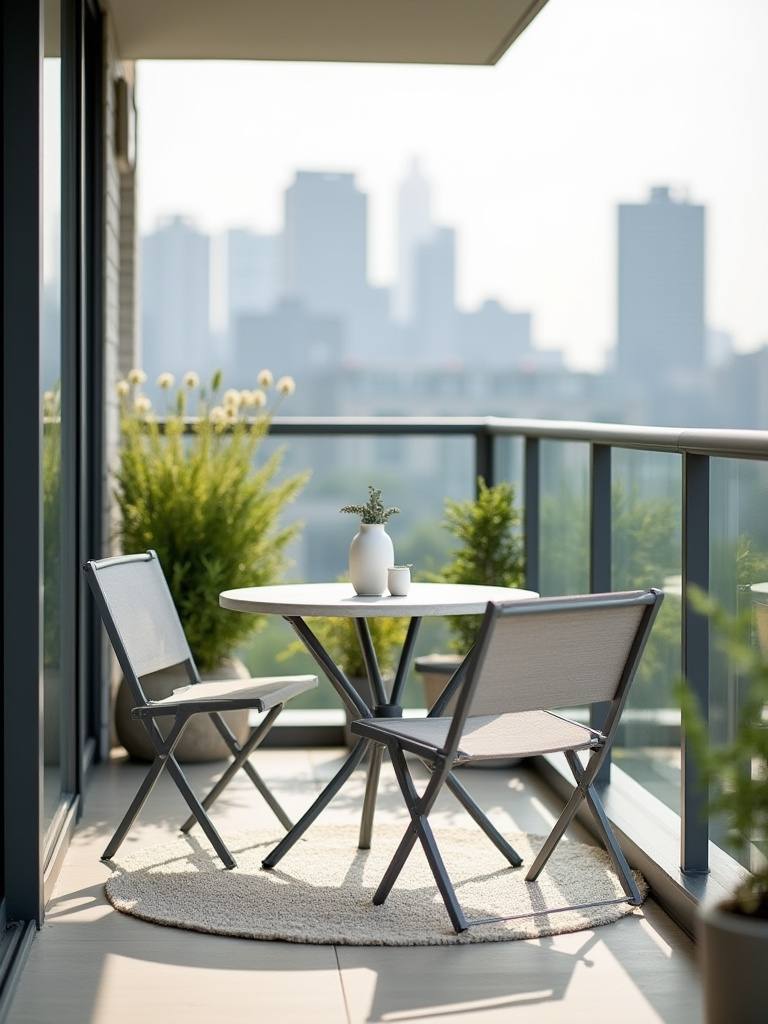
Start by asking your building management for the load capacity. This is your foundation. Then, measure the space. Feel its dimensions. Don’t just see the square footage; see the volume of air, the way the light falls at different times of day. By knowing these boundaries, you can choose pieces that are graceful and light—both in physical weight and in visual presence. This simple act of inquiry ensures that what you create is supported, safe, and in harmony with its structure.
With this understanding, we can choose objects that serve the space, rather than simply fill it.
2. Embrace Emptiness with Foldable Furniture
Western design often fears empty space. Japanese design reveres it. We call this concept ma (間). It is the pause in music, the unpainted silk in a scroll. On a balcony, furniture that can be folded away is the perfect expression of ma. It allows the space to serve multiple purposes—a place for coffee in the morning, an empty platform for meditation in the afternoon.

Choose a simple, well-made table and chairs that can be collapsed and stored against a wall. When they are put away, the floor is clear. The space feels open, larger, and full of possibility. This is not about “reclaiming floor space” as if it were a battle. It is about honoring the beauty of emptiness, allowing your balcony to be a place of quiet potential, ready for whatever moment you wish to create.
Now that the floor can breathe, let’s draw the eye upward, bringing life to the walls without cluttering our foundation.
3. Grow Upward: Using Vertical Space for Greenery
A connection to nature is essential for a peaceful spirit. On an apartment balcony, the earth is far below, so we must invite nature to climb up to us. Vertical planters allow you to create a living wall of green without sacrificing the precious ground plane you have so carefully preserved. This is a way to engage with the seasons, even many floors up.
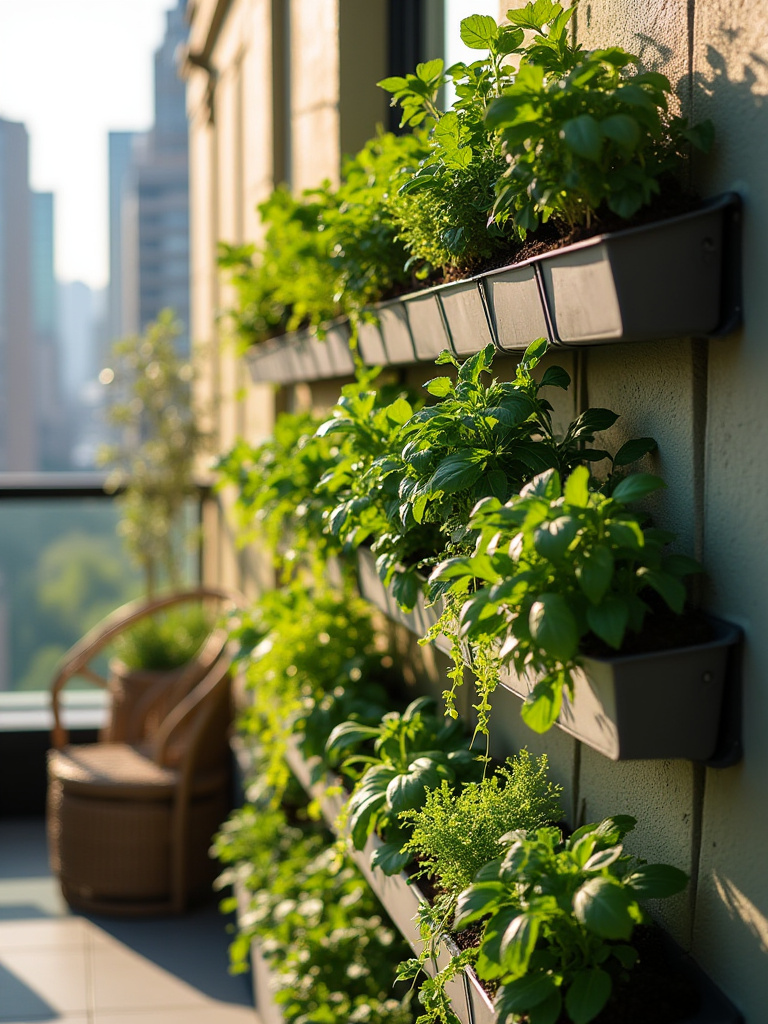
Choose a system that is simple and secure. A wall-mounted trellis with a climbing jasmine, or a series of stacked planters for herbs. The act of tending to these plants—watering them, watching them grow towards the light—becomes a moving meditation. The green wall is not just decoration. It is a quiet reminder of the persistent, gentle rhythm of the natural world. It can even create what we call komorebi (木漏れ日), the beautiful effect of sunlight filtering through leaves.
As your living wall flourishes, let’s consider where you will sit to admire it, blending comfort with uncluttered purpose.
4. Let Seating Serve a Deeper Purpose with Storage
Every object in a small space should have a clear intention. Often, it can have two. A bench that also holds your tools or cushions is an example of quiet efficiency. It is a philosophy of purposefulness, where form and function exist in perfect harmony. This is not about hiding clutter, but about creating a sense of order and calm.
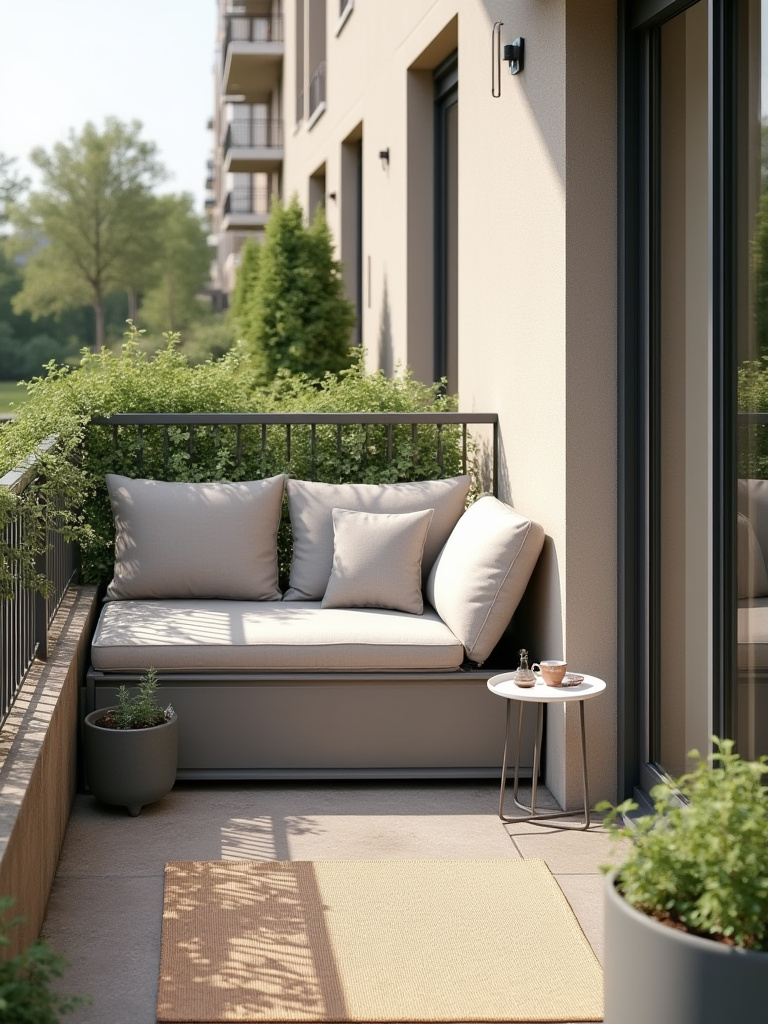
When selecting a bench or ottoman, look for simple lines and natural materials. The storage within should be an invisible feature, a silent partner in maintaining the serenity of the space. Inside, you can keep the few things you need: a soft blanket for cool evenings, a small watering can. When everything has its place, the mind feels more at ease. Your balcony becomes a space of organized tranquility.
With function and form in balance, we must now consider the materials themselves, ensuring they speak of permanence and respect for the elements.
5. Choose Materials That Endure with Grace
The things we choose to live with should have integrity. On a balcony, exposed to sun and rain, this is especially true. Selecting lightweight, weather-resistant materials is not just a practical choice for longevity; it is a philosophical one. It acknowledges that your space is part of the natural world, and the objects within it should be able to coexist with the elements gracefully.
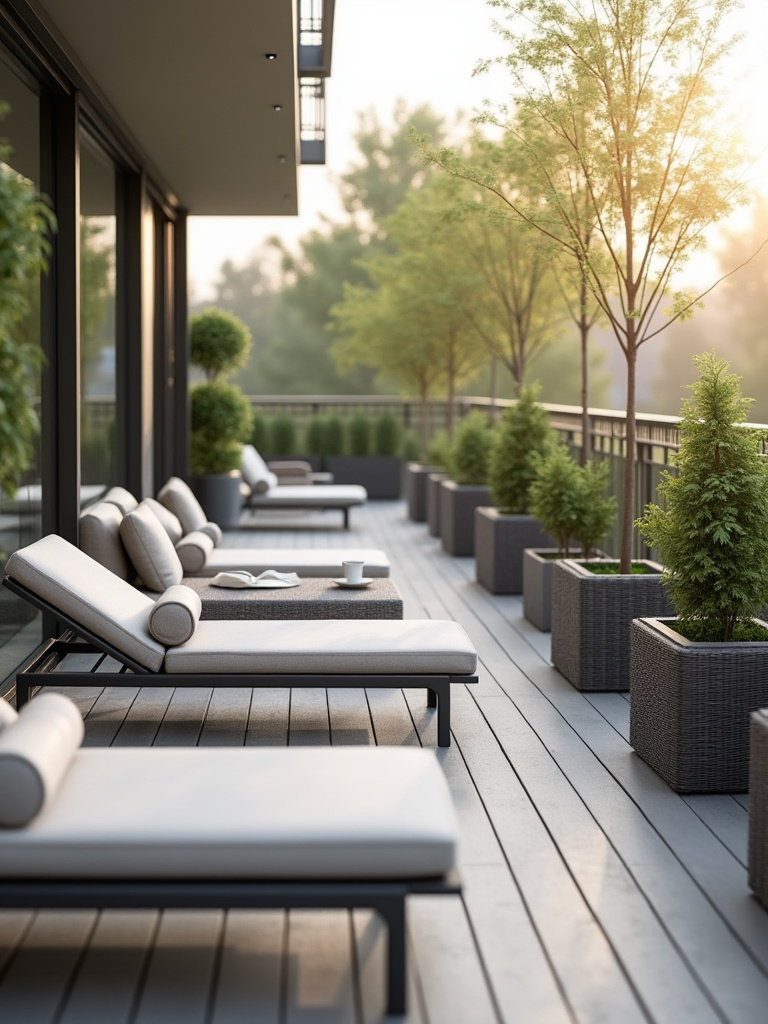
Materials like aluminum, cedar, or bamboo are both light and durable. They do not fight the wind and rain, but rather endure them. They carry a visual lightness that prevents a small space from feeling heavy or crowded. Choosing these materials is a commitment to quality over quantity. It is better to have one perfectly crafted bench that will age beautifully than a dozen plastic chairs that will fade and crack. This is the essence of wabi-sabi (侘寂): finding beauty in imperfection and appreciating the passage of time.
Now that we have built a foundation of safe, intentional, and enduring pieces, let’s soften the edges and invite comfort into our sanctuary.
Crafting Comfort and a Sense of Place
A space is not truly ours until it feels nurturing. Comfort is not about luxury, but about a sensory connection. It’s about the feeling of soft fabric, the glow of gentle light. Here, we move from the structure to the spirit, transforming the balcony into a place you will not just use, but inhabit.
6. Ground Yourself by Layering Outdoor Rugs
The floor of your balcony is your connection to the structure, to the earth below. Often, it is cold, hard concrete. To transform this surface is to transform the entire feeling of the space. Laying an outdoor rug is a simple act that immediately defines the space as a “room,” a place for living, rather than just an outdoor appendage. It is an invitation to take off your shoes, to feel a different texture underfoot.
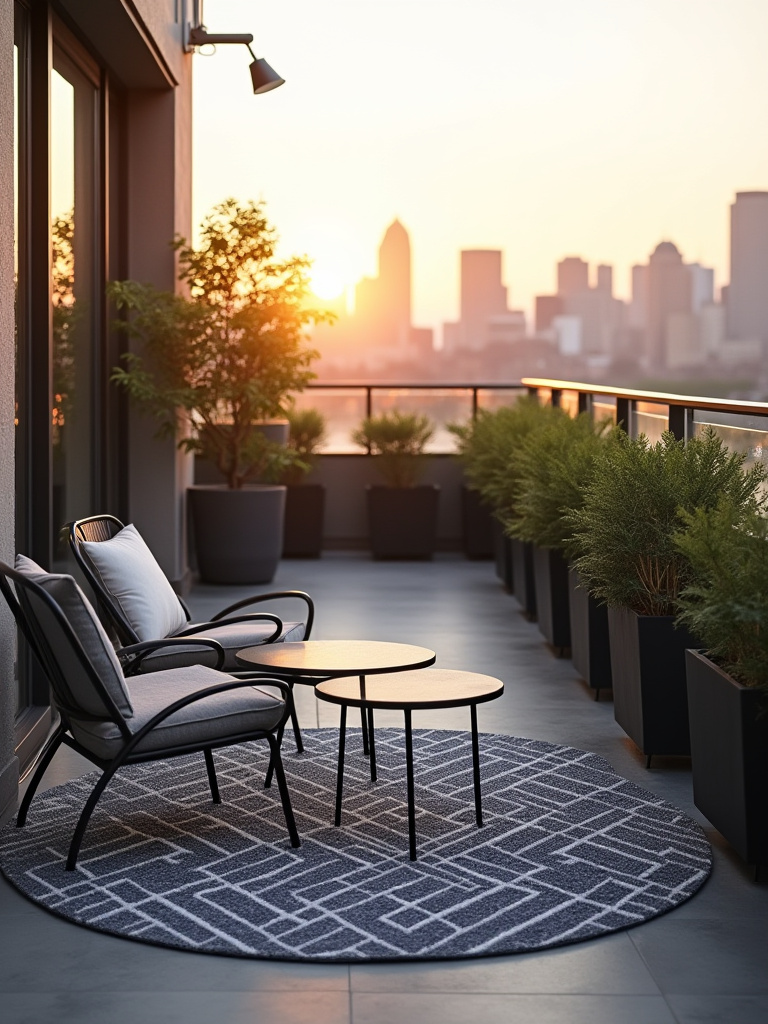
Choose a rug made of natural-feeling materials that can withstand the elements. You can then layer a smaller, softer rug on top to define a seating area. This layering adds depth and a tactile richness. Think of it not as decoration, but as creating a soft island of comfort. It signals to your body and mind that this is a place to slow down, to settle. It provides a literal and metaphorical foundation for relaxation.
With the ground softened, we turn to the air around us, shaping the light to create an atmosphere of evening serenity.
7. Invite the Evening with Gentle Light
In our culture, there is an appreciation for shadow and nuance called in’ei (陰翳). Light is most beautiful not when it is bright and harsh, but when it is soft, creating gentle shadows and a quiet mood. For your balcony, this is far more important than bright, functional illumination. string lights or a simple lantern are not just for seeing; they are for feeling.
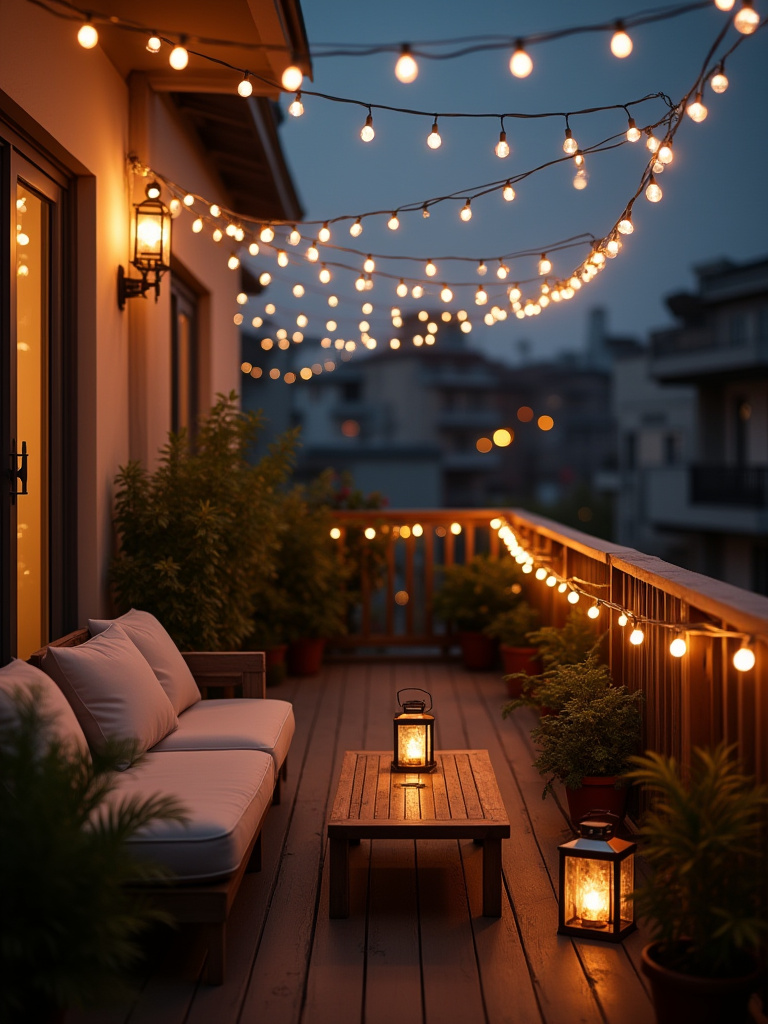
Choose lights that emit a warm, soft glow, like candlelight. Drape them simply along a railing or overhead. A single paper lantern, perhaps with a battery-powered candle inside, can be enough. The goal is to create pools of gentle light, leaving other areas in soft darkness. This interplay of light and shadow creates intimacy and a sense of peaceful enclosure, extending the life of your balcony into the quiet hours of the night.
As the light softens, let us add tactile comfort, making your chosen seat a place you will never want to leave.
8. Offer a Nurturing Embrace with Cushions and Throws
Comfort is a form of communication. A soft cushion invites you to sit and stay. A warm throw offers a feeling of being cared for and protected. These simple textiles are what transform a piece of furniture into a place of true rest. They are the final layer of welcome in your outdoor sanctuary.
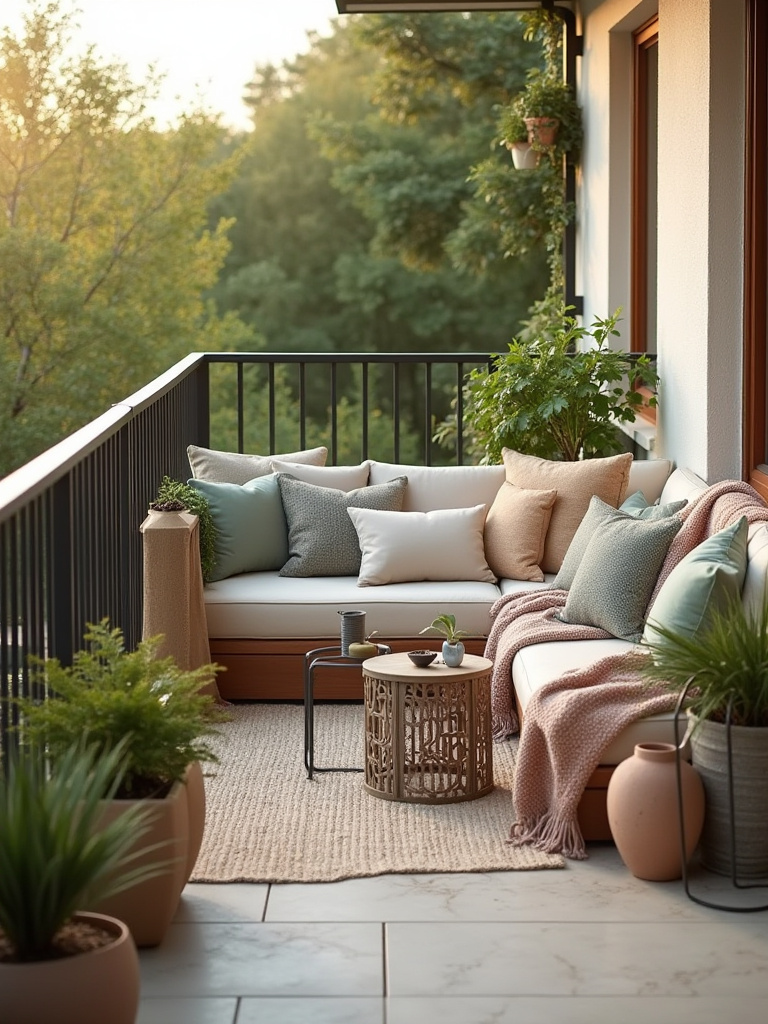
Select fabrics that feel good against the skin and are made to live outdoors. Natural colors and simple textures often create the most calming effect. Store them in your storage bench when not in use to protect them. The ritual of bringing out a cushion and a blanket to settle in for the evening becomes a meaningful act—a deliberate transition from the busyness of the day to a time of personal peace.
You now have a comfortable place to rest. Let us ensure there is also a place for the simple things that accompany quiet moments.
9. Create a Place for a Cup of Tea: The Small Table
A place of contemplation is often accompanied by a simple ritual: a morning cup of tea, an evening glass of water. A small, portable table provides a home for these things. It is a surface of convenience, yes, but it is also an anchor for the moment. Its presence gives you permission to pause.
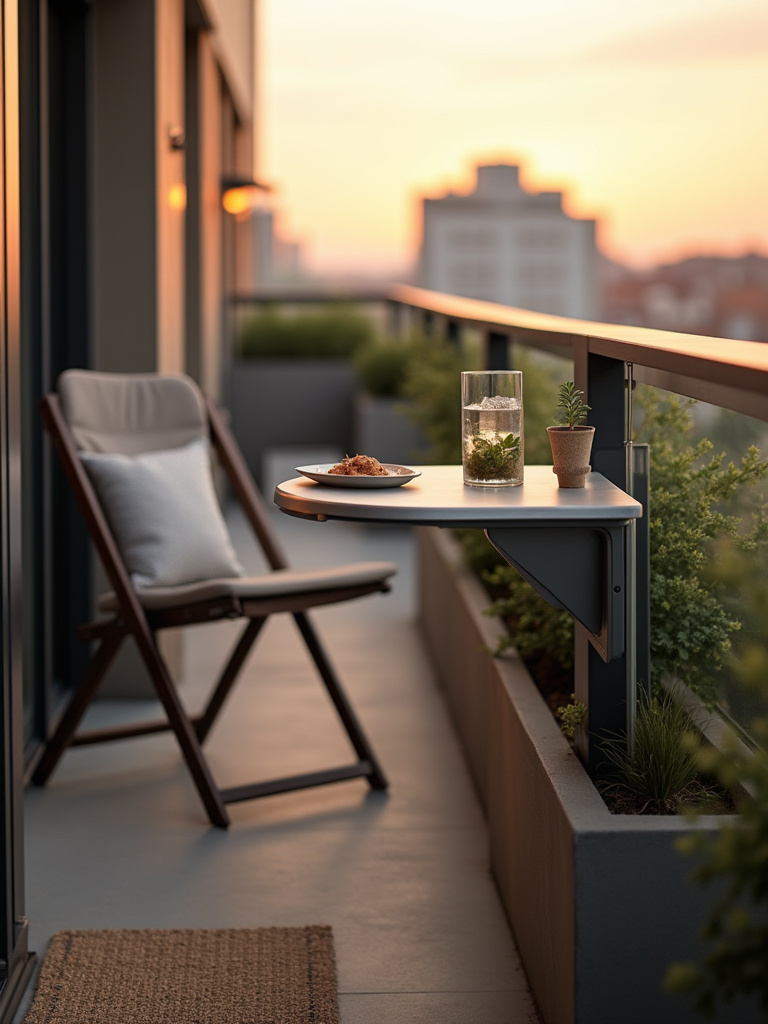
This table does not need to be large. A C-table that can slide over the arm of your chair, or a small folding tray, is often enough. It should be easily moved, allowing the space to remain flexible. By providing a dedicated spot for your book or your cup, you elevate the act of pausing. It becomes an intentional ritual, a small ceremony of self-care.
With all these elements in place, let’s unify them with a single, clear intention to create a truly harmonious atmosphere.
10. Find a Theme: The Art of Shibui
A space feels most peaceful when all its parts are in harmony. This does not mean everything must match. It means everything should feel as if it belongs together. This is the concept of shibui (渋い)—a simple, subtle, and unobtrusive beauty. Curating a theme is about finding your personal expression of shibui.
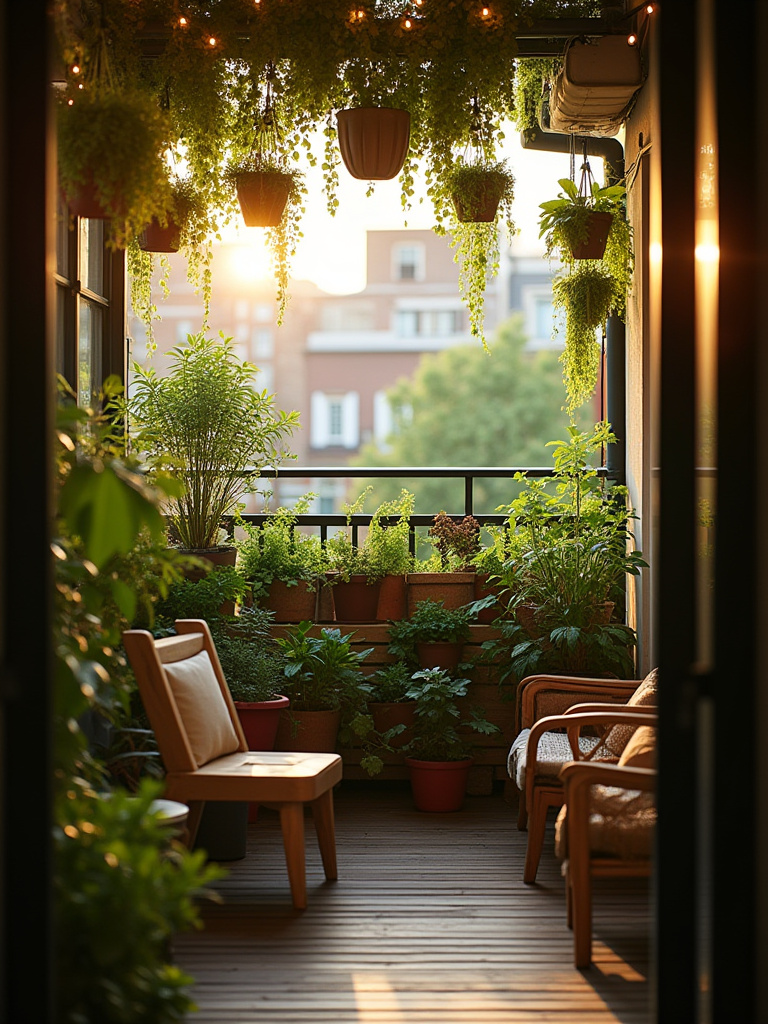
Your theme could be as simple as “a place to read” or “a garden for morning tea.” Let this guiding intention inform your choices. For a reading nook, the focus is on a comfortable chair and good light. For a tea garden, the focus is on the plants and a small table. This single thought acts as a filter, helping you resist the urge to add things that don’t serve the core purpose. It is the art of subtraction, of making every object count. This is how a balcony becomes more than a collection of things; it becomes a poem.
Bringing Nature and Function into Harmony
A true sanctuary connects us to the world outside ourselves. This means more than just being outdoors; it means actively inviting in the living world and ensuring the space functions with a quiet, invisible intelligence. It’s where the balcony becomes a place of both contemplation and gentle purpose.
11. Cultivate Life with Edible Herbs and Greens
To grow something you can eat is a profound connection to the cycles of life. Even on a small balcony, you can cultivate a pot of shiso, some mint for tea, or a few lettuce leaves. This act transforms the space from a passive place of rest into an active place of gentle creation. The flavor of a freshly picked herb is a reward that engages all the senses.
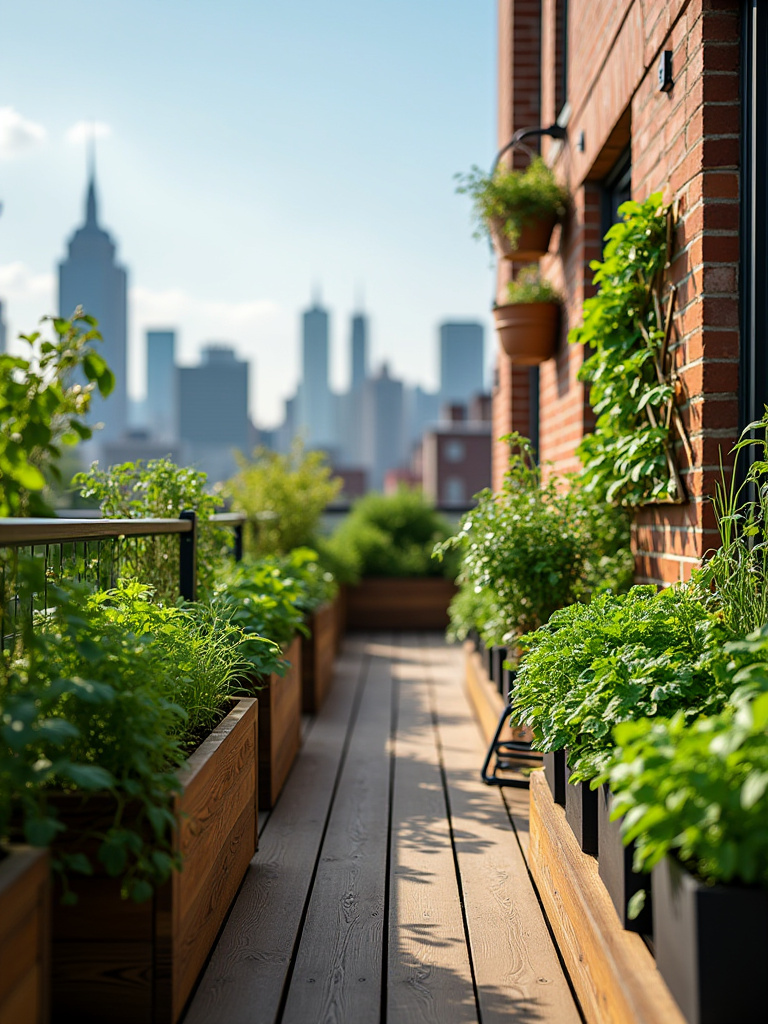
Choose plants that are happy in containers. Focus on one or two things you truly love to eat. Tending to them—watering, pruning—is a calming, mindful practice. An edible garden, no matter how small, grounds you in the present moment. It is a living, breathing part of your sanctuary that nourishes you in both body and spirit.
As your small garden provides for you, let’s consider how you can provide for its—and your—comfort by managing the sun and rain.
12. Mediate the Elements with Awnings or an Umbrella
A balcony is a place of negotiation with the elements. We cannot control the sun or the rain, but we can create shelter that allows us to enjoy their presence without being overwhelmed. A simple umbrella or a retractable awning is a tool for mediating this relationship. It allows you to create your own shade, your own refuge.
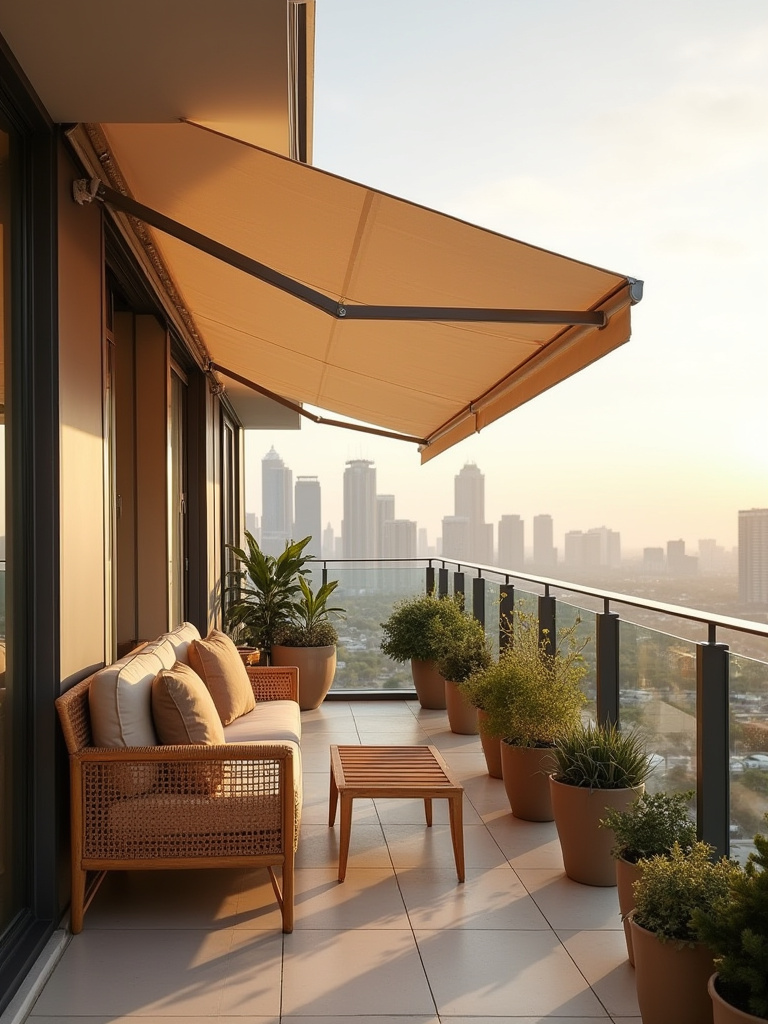
Choose a solution that is simple in form and function. Its purpose is to provide comfort, allowing you to sit outside during a light summer rain or in the heat of the afternoon sun. Being able to enjoy these moments connects you more deeply to the patterns of the day and the season. The shelter itself becomes a frame through which you can mindfully observe the weather.
With shelter established, we can use the same principle of filtering to create privacy, turning plants into a gentle veil.
13. Weave a Living Screen with Trellises and Climbing Plants
Privacy is not about building a wall to shut the world out. It is about creating a soft filter, a gentle veil that allows you to feel secluded without being isolated. A trellis with a climbing plant is a living screen. It obscures the view just enough, turning the gaze of neighbors or the distraction of the street into a soft, out-of-focus background.
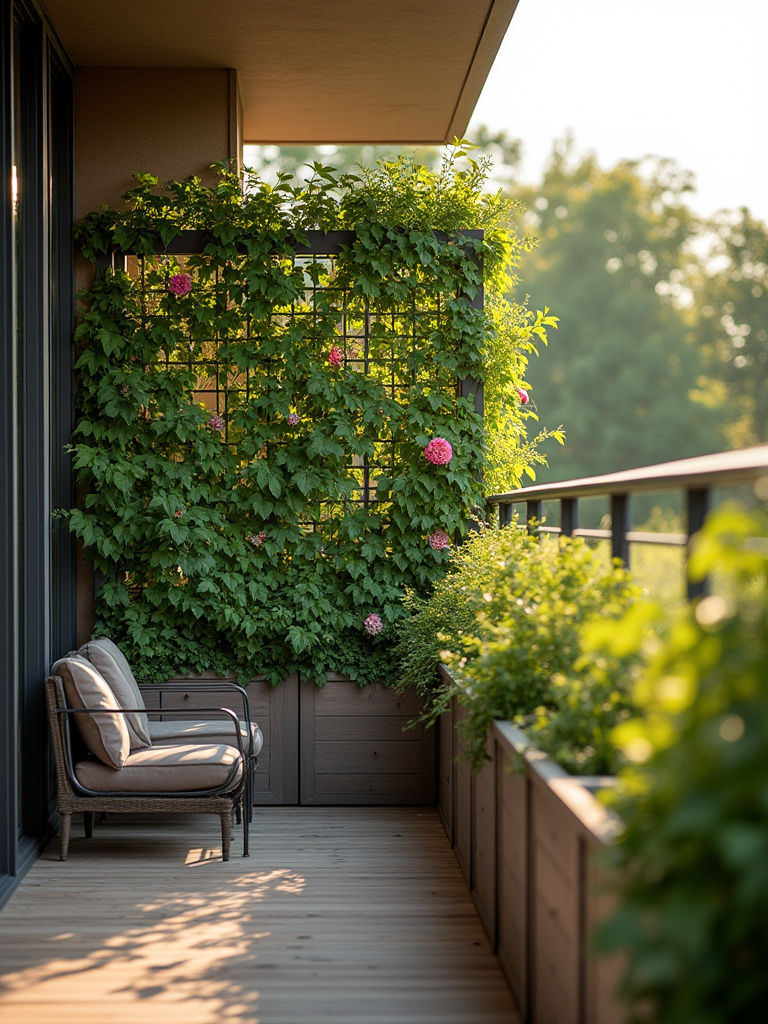
The gaps in the leaves still allow light and air to pass through, so the feeling is one of soft enclosure, not confinement. As the plant grows and changes through the seasons, your privacy screen is ever-evolving. Watching a vine weave its way through the structure is a lesson in patience and gentle persistence. It provides not just privacy, but beauty and a sense of life.
Behind this living screen, let’s ensure the space remains ordered and serene by turning to the walls for storage.
14. Keep the Floor Clear with Wall-Mounted Shelves
The floor of your balcony should remain as open as possible to preserve that feeling of ma, or meaningful space. Wall-mounted shelves allow you to store the few things you need—a small pot, a candle, a tool—without cluttering the ground. They lift the energy of the space upward.
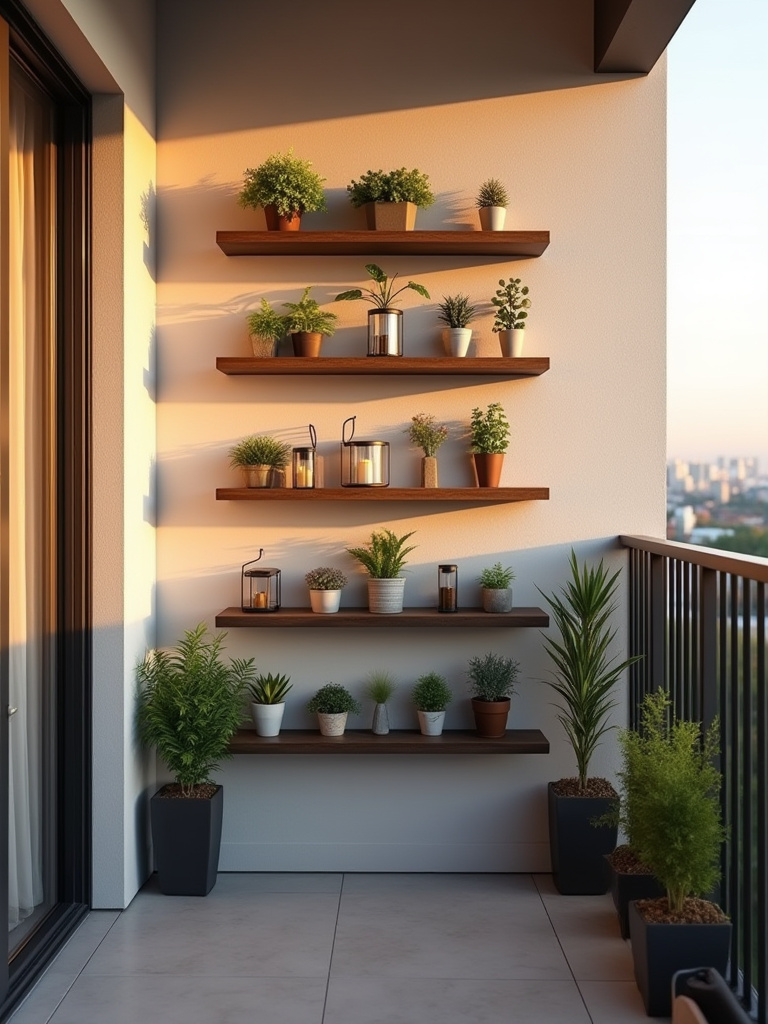
Choose simple, unobtrusive shelves made from materials that echo the rest of your balcony. A single plank of weathered wood or a narrow metal shelf can be enough. Arrange only a few, carefully chosen objects on them. These shelves are not for bulk storage; they are curated platforms for beautiful, useful things. They bring order and purpose to the vertical plane.
To this symphony of the senses—touch, sight, smell—let us now add the most meditative of all: the gentle sound of water.
15. Introduce the Voice of Water
In a Zen garden, the sound of water is as important as the sight of the stones. A small fountain on a balcony brings this same powerful, calming element to your urban home. The gentle sound of trickling water has a unique ability to quiet the mind and mask the harsh sounds of the city.
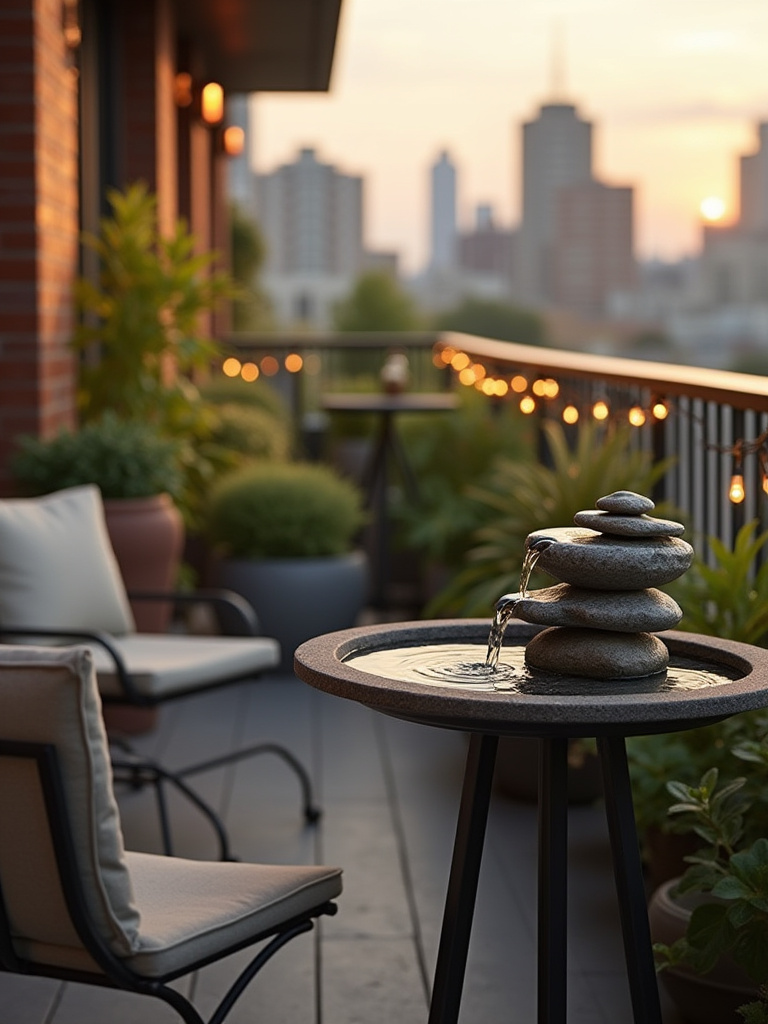
A simple, self-contained tabletop fountain is all that is needed. The visual of moving water is mesmerizing, and the sound creates a constant, peaceful presence. It is a focal point for meditation. Closing your eyes and listening only to the water is a practice that can dissolve stress and bring you firmly into the present moment. This single element can do more to create a sanctuary than almost anything else.
Deepening the Practice: Customization & Personal Ritual
When the foundation is set, you can begin to add layers that are uniquely yours. These are not about decoration, but about deepening the sense of personal retreat. They are the final touches that make the space not just a well-designed balcony, but a reflection of your inner world.
16. Create Enclosure with Screens or Bamboo Panels
While a living screen of plants is beautiful, sometimes a more complete sense of enclosure is needed to create a true feeling of a private outdoor room. A simple screen of bamboo or a translucent panel can provide this. It is a way of defining your space, of saying, “Here, inside this boundary, is a place of peace.”
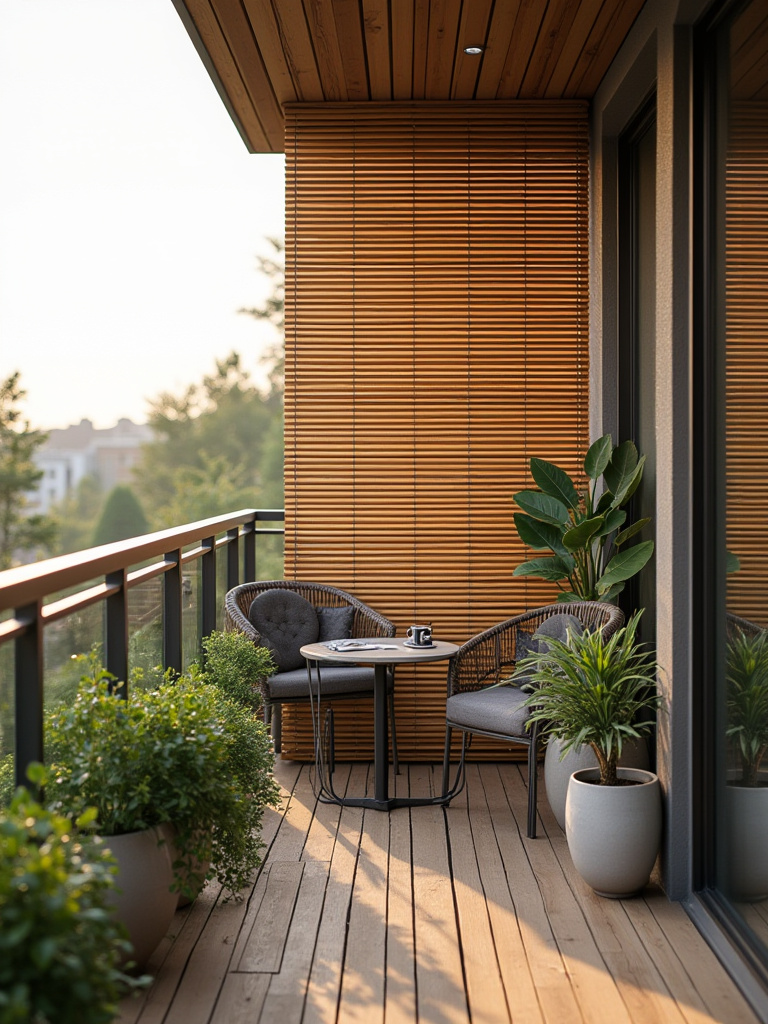
This screen acts as the shoji screen does in a traditional Japanese home. It separates the space without isolating it. It filters the light and the view, creating a soft, protected feeling. It allows you to feel fully at ease, knowing you are in your own private world, even in the middle of a bustling city. The security it provides is not just physical, but psychological.
Now that your sanctuary feels truly private, we can illuminate it with a light that is both gentle and self-sufficient.
17. Use the Sun’s Energy for Light
There is a simple elegance in using the power of the sun to light your evenings. Solar-powered lights require no wires, no connection to the grid. They are self-sufficient, gathering energy quietly during the day and releasing it as a soft glow at night. This reflects a harmony with nature’s cycles.
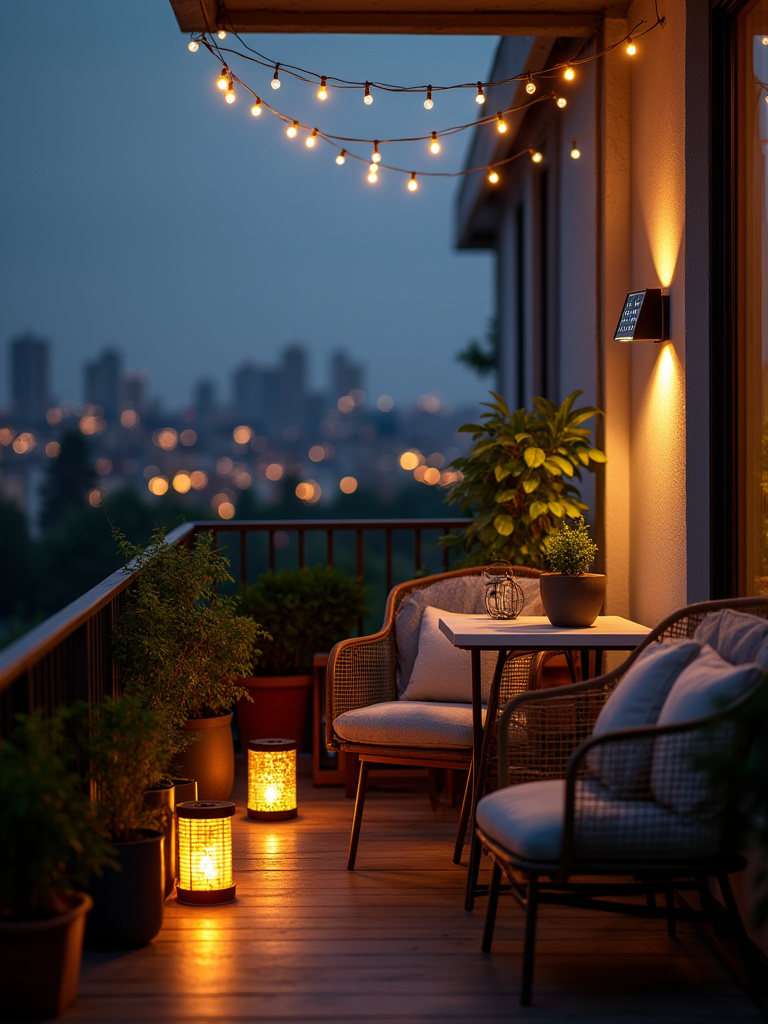
Place a few small solar stakes in your planters or a string of tiny solar lights along a rail. The light they provide is often subtle, which is perfect for maintaining a contemplative mood. Using them is an act of sustainability and simplicity. It is a quiet acknowledgment of your connection to the larger forces of the world, drawing power directly from the sky above.
With light, privacy, and comfort established, let’s turn our attention back to the floor, imbuing it with renewed life.
18. Renew the Foundation by Painting or Staining
Over time, the floor of a balcony can become weathered and tired. The act of refinishing this surface is a powerful ritual of renewal. To paint or stain the decking tiles is to give them new character, a new life. This is not just maintenance; it is an act of care and intention.
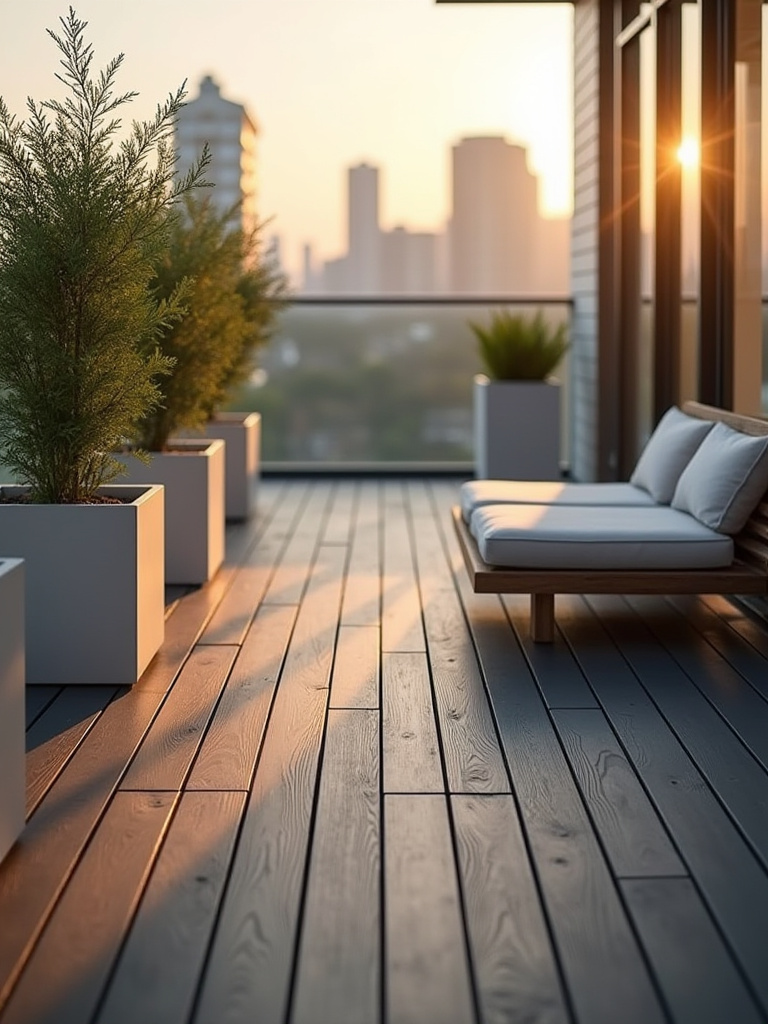
Choose a color that is calming and grounding—a deep charcoal grey, a soft moss green, or a warm natural wood tone. The process itself can be meditative: the careful preparation, the steady brushstrokes. When finished, the entire space feels refreshed and coherent. You are standing on a foundation that you have personally renewed, and this brings a deep sense of satisfaction and connection to the space.
Upon this renewed foundation, you can now create the ultimate expression of purpose: a space dedicated to a single, peaceful act.
19. Build a Nook for Contemplation
The final step is to create a space for a single, cherished purpose. A built-in reading nook is a perfect example. It is seating, storage, and intention all in one. By building a simple bench into a corner, you create a permanent invitation to pause. You are designing a piece of your balcony with the sole purpose of rest and contemplation.
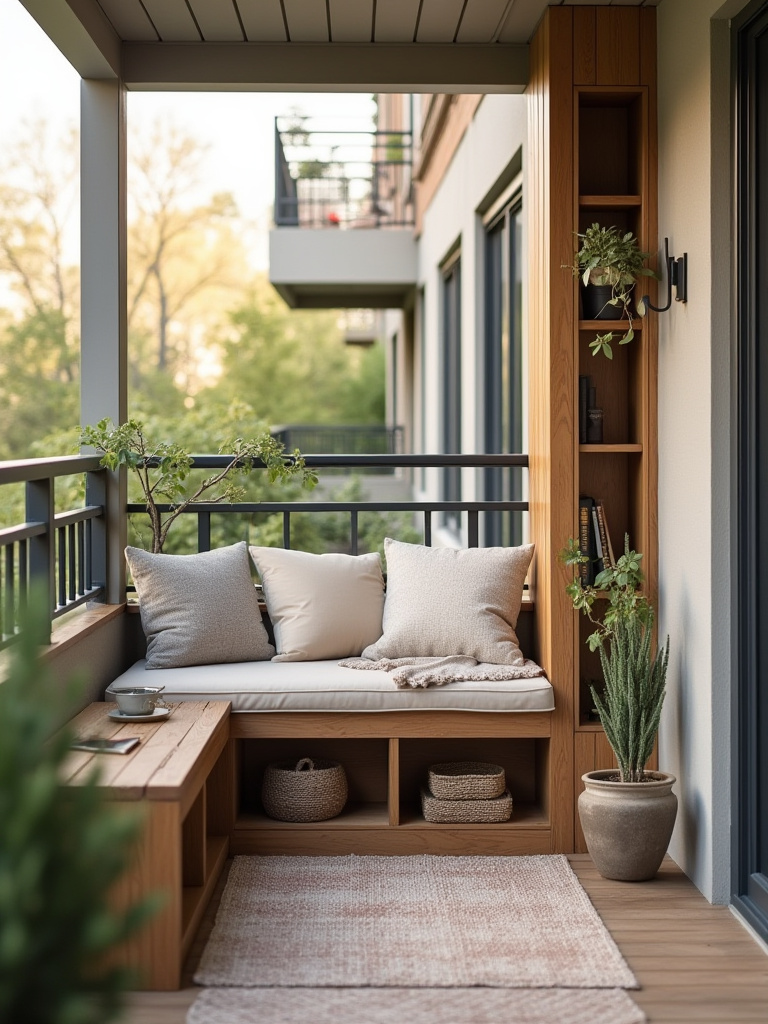
This nook becomes the heart of your sanctuary. Its built-in nature makes it feel like an integral part of the architecture, a truly intentional design. With storage beneath for your book and a blanket, and a cushion on top, it is a complete world unto itself. It is the ultimate expression of transforming a simple balcony into a sacred space, designed not just for living, but for being.
Conclusion
You see, creating a sanctuary on your balcony is not about following a list of trends. It is a practice. It is about paying attention. It is about understanding that a small space does not require small ideas, but rather, a more profound understanding of space itself. Each choice—from the weight of a chair to the sound of a small fountain—is a step toward creating harmony.
Do not feel you must do everything at once. Begin with one thing. Perhaps it is clearing the space completely and just sitting with the emptiness for a while. Or maybe it is adding a single, beautiful plant. The journey is as important as the destination. Let the process be slow, thoughtful, and joyful. Your balcony is not an afterthought. It is a threshold, a place of potential. It is an opportunity to create a small pocket of stillness in a fast-moving world. Create a space that nurtures you, and you will find yourself drawn to it, day after day.
